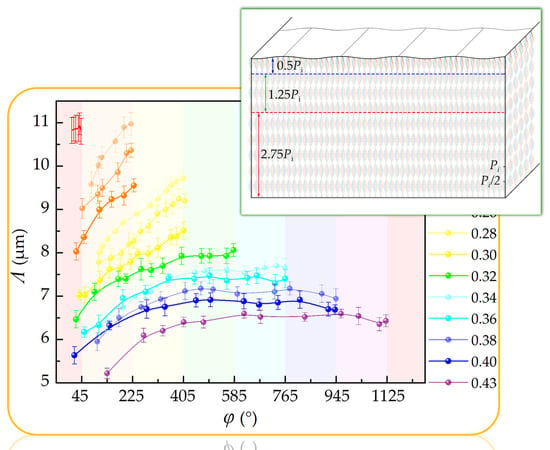Light-Driven Rotation and Pitch Tuning of Self-Organized Cholesteric Gratings Formed in a Semi-Free Film
Abstract
:1. Introduction
2. Materials and Methods
2.1. Matearials
2.2. Methods
3. Results and Discussion
3.1. Light-Driven Rotation and Pitch Tuning Behaviours
3.2. Modelling of Director Configuration
3.3. Two-Dimentional Precise Beam Steering
3.4. Synchronous Microparticle Rotation
4. Conclusions
Supplementary Materials
Acknowledgments
Author Contributions
Conflicts of Interest
References
- Jau, H.C.; Li, Y.; Li, C.C.; Chen, C.W.; Wang, C.T.; Bisoyi, H.K.; Lin, T.H.; Bunning, T.J.; Li, Q. Light-driven wide-range nonmechanical beam steering and spectrum scanning based on a self-organized liquid crystal grating enabled by a chiral molecular switch. Adv. Opt. Mater. 2015, 3, 166–170. [Google Scholar] [CrossRef]
- Kang, S.-W.; Sprunt, S.; Chien, L.-C. Polymer-stabilized cholesteric diffraction gratings: Effects of uv wavelength on polymer morphology and electrooptic properties. J. Am. Chem. Soc. 2006, 18, 1436–1441. [Google Scholar] [CrossRef]
- Kang, S.W.; Sprunt, S.; Chien, L.C. Structure and morphology of polymer-stabilized cholesteric diffraction gratings. Appl. Phys. Lett. 2000, 76, 3516. [Google Scholar] [CrossRef]
- Ma, L.-L.; Li, S.-S.; Li, W.-S.; Ji, W.; Luo, B.; Zheng, Z.-G.; Cai, Z.-P.; Chigrinov, V.; Lu, Y.-Q.; Hu, W.; Chen, L.-J. Rationally designed dynamic superstructures enabled by photoaligning cholesteric liquid crystals. Adv. Opt. Mater. 2015, 3, 1691–1696. [Google Scholar] [CrossRef]
- Li, W.-S.; Ma, L.-L.; Gong, L.-L.; Li, S.-S.; Yang, C.; Luo, B.; Hu, W.; Chen, L.-J. Interlaced cholesteric liquid crystal fingerprint textures via sequential uv-induced polymer-stabilization. Opt. Mater. Express 2016, 6, 19–28. [Google Scholar] [CrossRef]
- Hung, W.-C.; Cheng, W.-H.; Liu, T.-K.; Jiang, I.M.; Tsai, M.-S.; Yeh, P. Diffraction of cholesteric liquid crystal gratings probed by monochromatic light from 450 to 750 nm. J. Appl. Phys. 2008, 104, 073106. [Google Scholar] [CrossRef]
- Yao, I.A.; Liaw, C.-H.; Chen, S.-H.; Wu, J.-J. Direction-tunable cholesteric phase gratings. J. Appl. Phys. 2004, 96, 1760–1762. [Google Scholar] [CrossRef]
- Igor Gvozdovskyy, O.Y.; Serbina, M.; Yamaguchi, R. Photoinduced helical inversion in cholesteric liquid crystal cells with homeotropic anchoring. Opt. Express 2012, 20, 3499–3508. [Google Scholar] [CrossRef] [PubMed]
- Oswald, P.; Baudry, J.; Pirkl, S. Static and dynamic properties of cholesteric fingers in electric field. Phys. Rep. 2000, 337, 67–96. [Google Scholar] [CrossRef]
- Khoo, I.C.; Xiang, J.; Shiyanovskii, S.V.; Li, Y.; Imrie, C.T.; Li, Q.; Lavrentovich, O.D. Electrooptics of chiral nematics formed by molecular dimers. Proc. SPIE Liq. Cryst. XVIII 2014, 91820P. [Google Scholar] [CrossRef]
- Ryabchun, A.; Bobrovsky, A.; Stumpe, J.; Shibaev, V. Rotatable diffraction gratings based on cholesteric liquid crystals with phototunable helix pitch. Adv. Opt. Mater. 2015, 3, 1273–1279. [Google Scholar] [CrossRef]
- Baudry, J.; Brazovskaia, M.; Lejcek, L.; Oswald, P.; Pirkl, S. Arch-texture in cholesteric liquid crystals. Liq. Cryst. 1996, 21, 893–901. [Google Scholar] [CrossRef]
- Lin, C.-H.; Chiang, R.-H.; Liu, S.-H.; Kuo, C.-T.; Huang, C.-Y. Rotatable diffractive gratings based on hybrid-aligned cholesteric liquid crystals. Opt. Express 2012, 20, 26837–26844. [Google Scholar] [CrossRef] [PubMed]
- Hung, W.-C.; Cheng, W.-H.; Tsai, M.-S.; Juan, Y.-C.; Jiang, I.M.; Yeh, P. Surface plasmon enhanced diffraction in cholesteric liquid crystals. Appl. Phys. Lett. 2007, 90, 183115. [Google Scholar] [CrossRef]
- Nose, T.; Miyanishi, T.; Aizawa, Y.; Ito, R.; Honma, M. Rotational behavior of stripe domains appearing in hybrid aligned chiral nematic liquid crystal cells. Jpn. J. Appl. Phys. 2010, 49, 051701. [Google Scholar] [CrossRef]
- Zheng, Z.-G.; Li, Y.; Bisoyi, H.K.; Wang, L.; Bunning, T.J.; Li, Q. Three-dimensional control of the helical axis of a chiral nematic liquid crystal by light. Nature 2016, 531, 352–356. [Google Scholar] [CrossRef] [PubMed]
- Wang, Y.; Li, Q. Light-driven chiral molecular switches or motors in liquid crystals. Adv. Mater. 2012, 24, 1926–1945. [Google Scholar] [CrossRef] [PubMed]
- Xiang, J.; Shiyanovskii, S.V.; Imrie, C.; Lavrentovich, O.D. Electrooptic response of chiral nematic liquid crystals with oblique helicoidal director. Phys. Rev. Lett. 2014, 112, 217801. [Google Scholar] [CrossRef]
- Ryabchun, A.; Bobrovsky, A.; Stumpe, J.; Shibaev, V. Electroinduced diffraction gratings in cholesteric polymer with phototunable helix pitch. Adv. Opt. Mater. 2015, 3, 1462–1469. [Google Scholar] [CrossRef]
- Khoo, I.-C.; Senyuk, B.; Smalyukh, I.; Lavrentovich, O. Electrically-controlled two-dimensional gratings based on layers undulations in cholesteric liquid crystals. Proc. SPIE Liq. Cryst. IX 2005, 59360W. [Google Scholar] [CrossRef]
- Zhang, L.; Wang, L.; Hiremath, U.S.; Bisoyi, H.K.; Nair, G.G.; Yelamaggad, C.V.; Urbas, A.M.; Bunning, T.J.; Li, Q. Dynamic orthogonal switching of a thermoresponsive self-organized helical superstructure. Adv. Mater. 2017, 29, 1700676. [Google Scholar] [CrossRef] [PubMed]
- Jeong, H.S.; Kim, Y.H.; Lee, J.S.; Kim, J.H.; Srinivasarao, M.; Jung, H.T. Chiral nematic fluids as masks for lithography. Adv. Mater. 2012, 24, 381–384. [Google Scholar] [CrossRef] [PubMed]
- Kim, Y.; Tamaoki, N. A photoresponsive planar chiral azobenzene dopant with high helical twisting power. J. Mater. Chem. C 2014, 2, 9258–9264. [Google Scholar] [CrossRef]
- Eelkema, R.; Pollard, M.M.; Vicario, J.; Katsonis, N.; Ramon, B.S.; Bastiaansen, C.W.; Broer, D.J.; Feringa, B.L. Molecular machines: Nanomotor rotates microscale objects. Nature 2006, 440, 163. [Google Scholar] [CrossRef] [PubMed]
- Ayeb, H.; Grand, J.; Sellame, H.; Truong, S.; Aubard, J.; Felidj, N.; Mlayah, A.; Lacaze, E. Gold nanoparticles in a cholesteric liquid crystal matrix: Self-organization and localized surface plasmon properties. J. Mater. Chem. 2012, 22, 7856–7862. [Google Scholar] [CrossRef]
- Eelkema, R.; Pollard, M.M.; Katsonis, N.; Vicario, J.; Broer, D.J.; Feringa, B.L. Rotational reorganization of doped cholesteric liquid crystalline films. J. Am. Chem. Soc. 2006, 128, 14397–14407. [Google Scholar] [CrossRef] [PubMed]
- Mitov, M.; Portet, C.; Bourgerette, C.; Snoeck, E.; Verelst, M. Long-range structuring of nanoparticles by mimicry of a cholesteric liquid crystal. Nat. Mater. 2002, 1, 229–231. [Google Scholar] [CrossRef] [PubMed]
- Thomas, R.; Yoshida, Y.; Akasaka, T.; Tamaoki, N. Influence of a change in helical twisting power of photoresponsive chiral dopants on rotational manipulation of micro-objects on the surface of chiral nematic liquid crystalline films. Chem. Eur. J. 2012, 18, 12337–12348. [Google Scholar] [CrossRef] [PubMed]
- Bosco, A.; Jongejan, M.G.; Eelkema, R.; Katsonis, N.; Lacaze, E.; Ferrarini, A.; Feringa, B.L. Photoinduced reorganization of motor-doped chiral liquid crystals: Bridging molecular isomerization and texture rotation. J. Am. Chem. Soc. 2008, 130, 14615–14624. [Google Scholar] [CrossRef] [PubMed]
- Chigrinov, V.G.; Kozenkov, V.M.; Kwok, H.S. Photoalignment of Liquid Crystalline Materials: Physics and Applications; John Wiley & Sons: West Sussex, UK, 2008; pp. 69–100. [Google Scholar]
- Hu, W.; Kumar Srivastava, A.; Lin, X.W.; Liang, X.; Wu, Z.J.; Sun, J.T.; Zhu, G.; Chigrinov, V.G.; Lu, Y.Q. Polarization independent liquid crystal gratings based on orthogonal photoalignments. Appl. Phys. Lett. 2012, 100, 111116. [Google Scholar] [CrossRef]
- Srivastava, A.K.; Hu, W.; Chigrinov, V.G.; Kiselev, A.D.; Lu, Y.Q. Fast switchable grating based on orthogonal photo alignments of ferroelectric liquid crystals. Appl. Phys. Lett. 2012, 101, 031112. [Google Scholar] [CrossRef]
- Wu, H.; Hu, W.; Hu, H.C.; Lin, X.W.; Zhu, G.; Choi, J.W.; Chigrinov, V.G.; Lu, Y.Q. Arbitrary photo-patterning in liquid crystal alignments using dmd based lithography system. Opt. Express 2012, 20, 16684–16689. [Google Scholar] [CrossRef]
- Hsiao, Y.-C.; Huang, K.-C.; Lee, W. Photo-switchable chiral liquid crystal with optical tristability enabled by a photoresponsive azo-chiral dopant. Opt. Express 2017, 25, 2687–2693. [Google Scholar] [CrossRef]
- Huang, K.C.; Hsiao, Y.C.; Timofeev, I.V.; Zyryanov, V.Y.; Lee, W. Photo-manipulated photonic bandgap devices based on optically tristable chiral-tilted homeotropic nematic liquid crystal. Opt. Express 2016, 24, 25019–25025. [Google Scholar] [CrossRef] [PubMed]
- Chen, C.-W.; Li, C.-C.; Jau, H.-C.; Lee, C.-H.; Wang, C.-T.; Lin, T.-H. Bistable light-driven π phase switching using a twisted nematic liquid crystal film. Opt. Express 2014, 22, 12133–12138. [Google Scholar] [CrossRef] [PubMed]
- De Gennes, P.G.; Prost, J. The Physics of Liquid Crystals; Clarendon: Oxford, UK, 1993. [Google Scholar]
- Kausar, A.; Nagano, H.; Ogata, T.; Nonaka, T.; Kurihara, S. Photocontrolled translational motion of a microscale solid object on azobenzene-doped liquid-crystalline films. Angew. Chem. Int. Ed. 2009, 48, 2144–2147. [Google Scholar] [CrossRef] [PubMed]
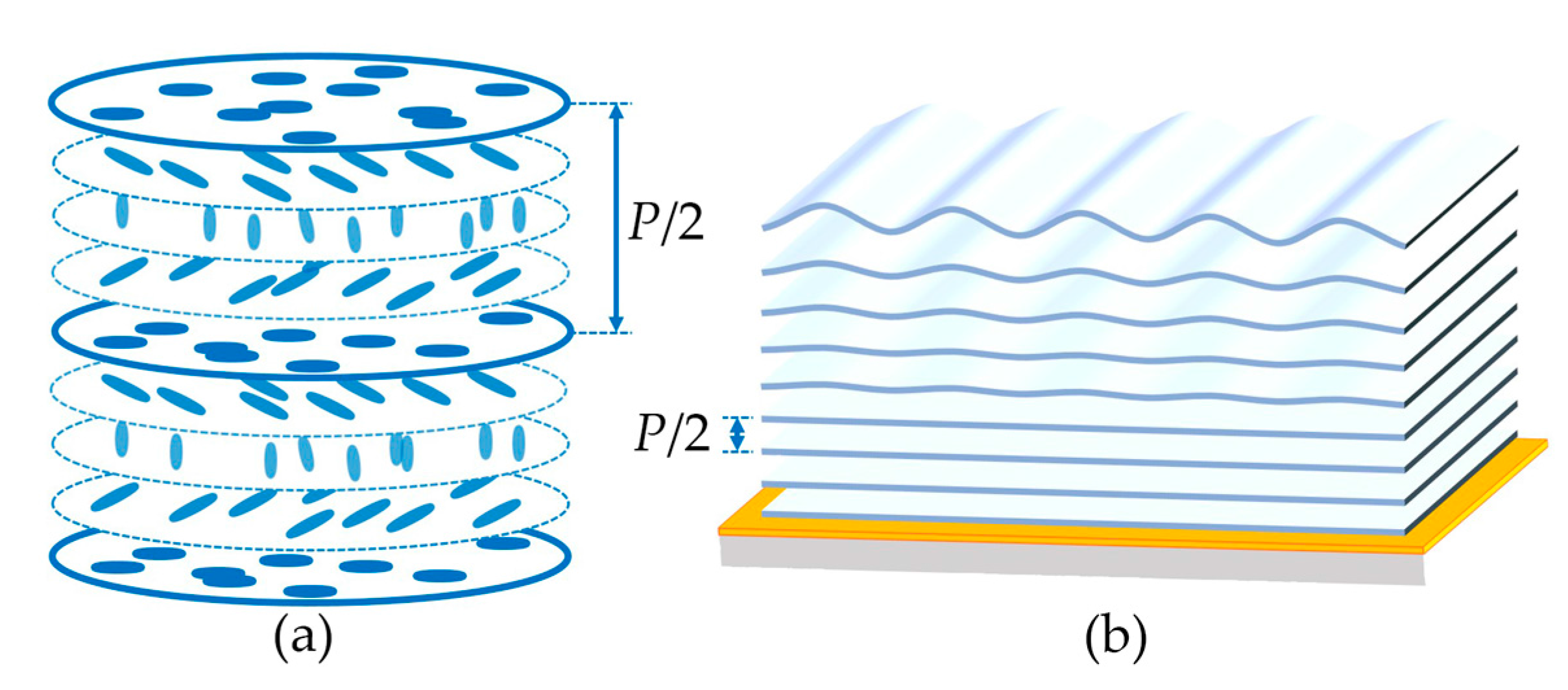
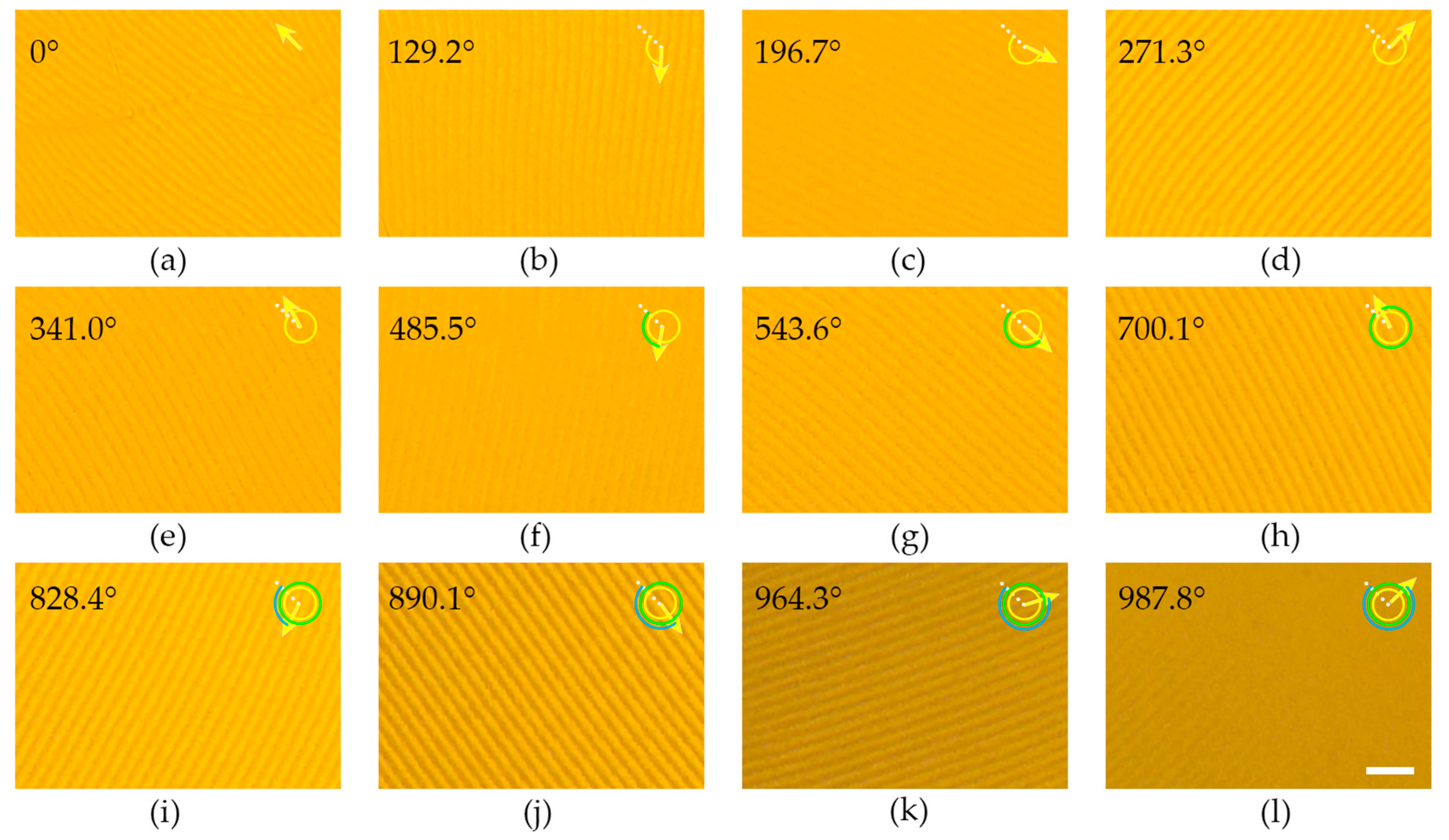
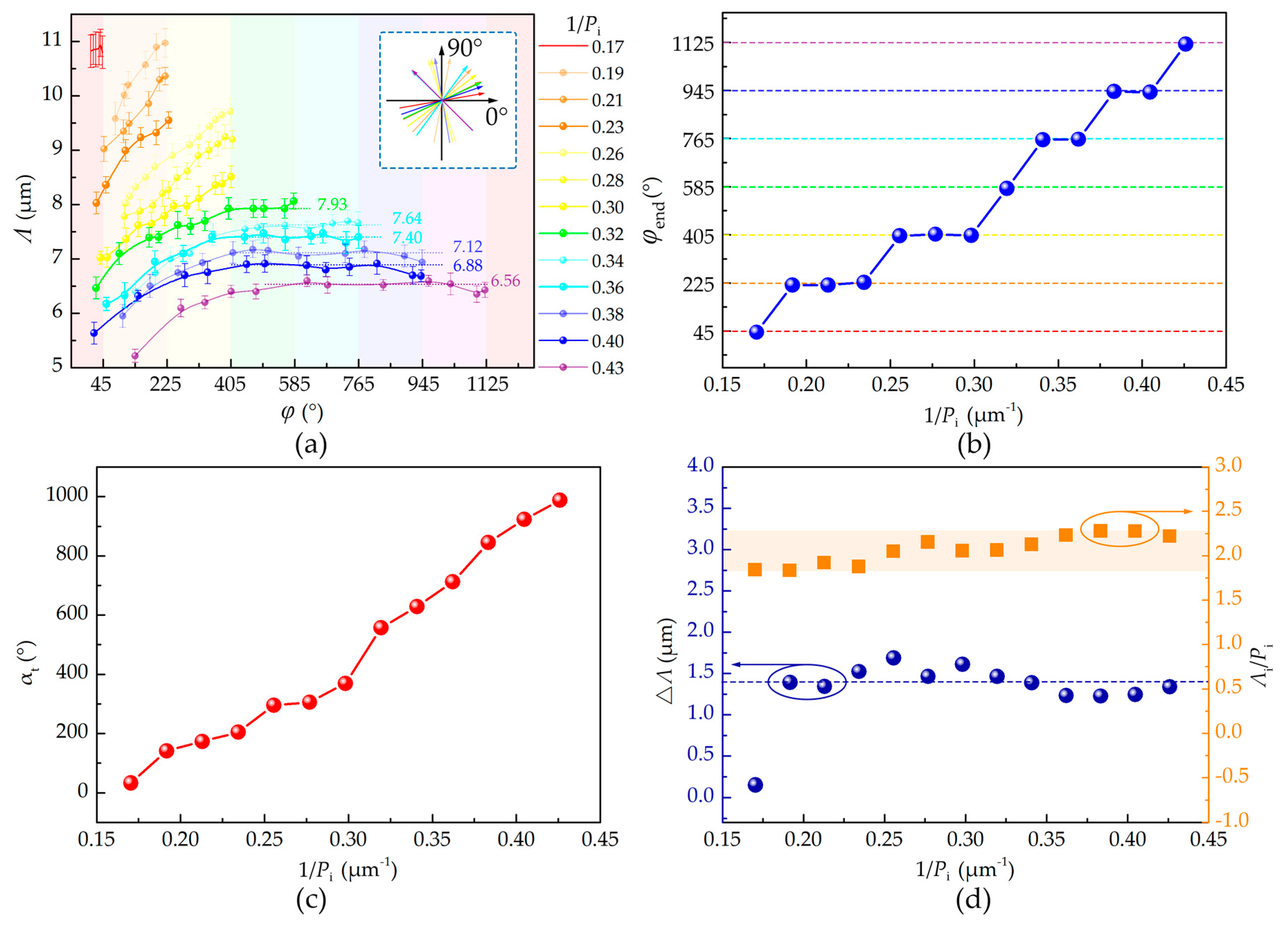
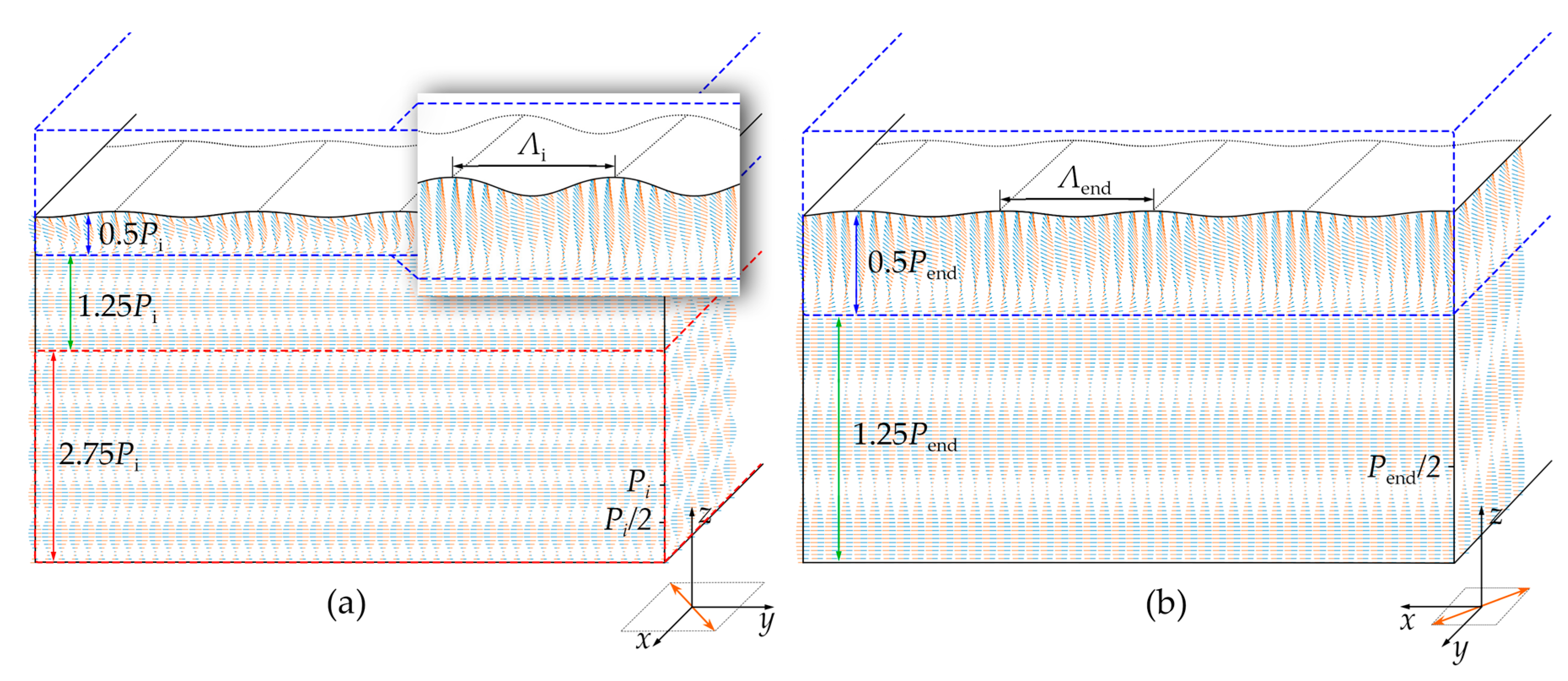
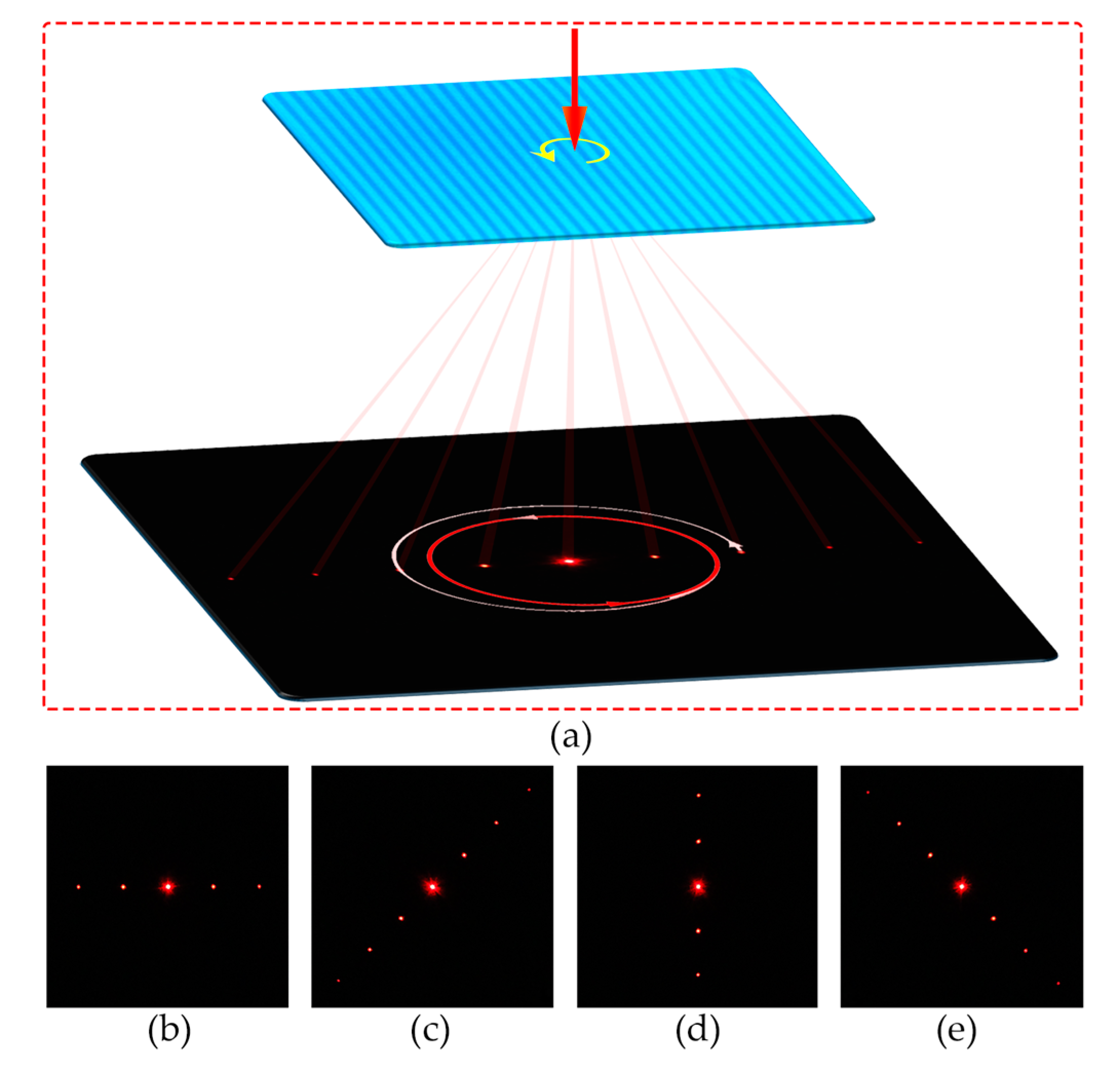
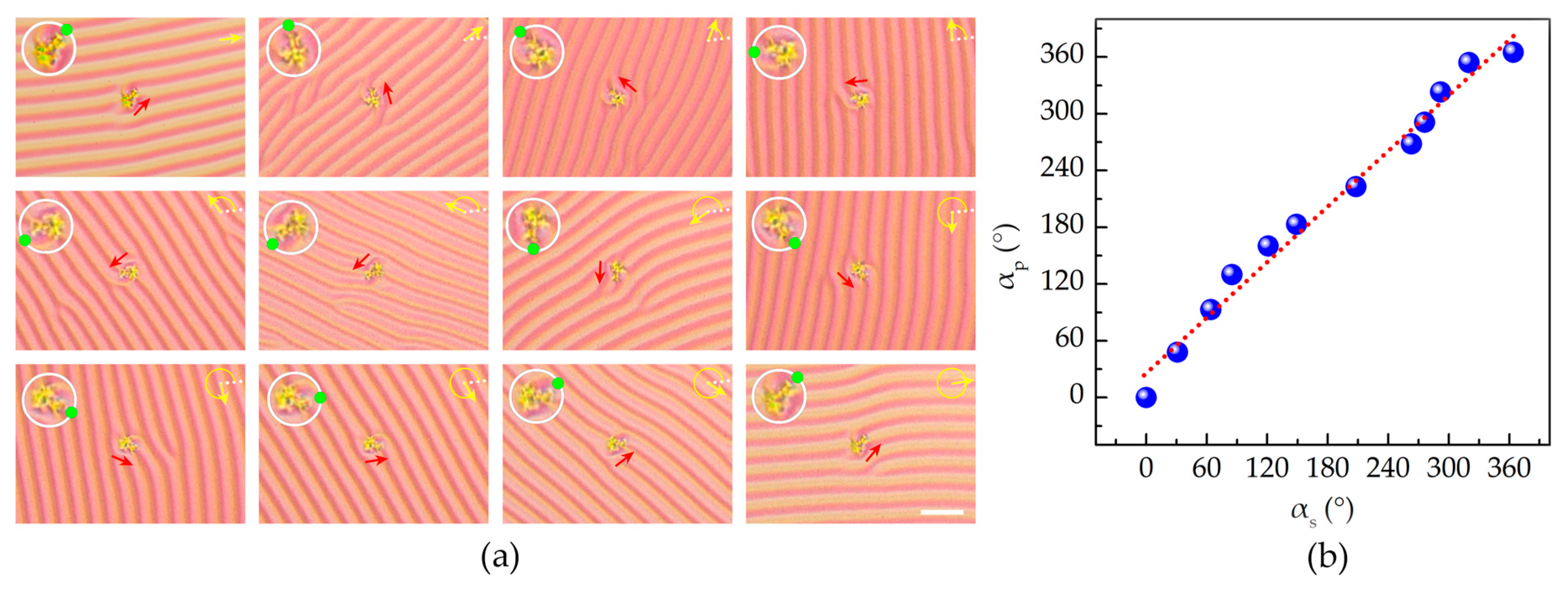
© 2017 by the authors. Licensee MDPI, Basel, Switzerland. This article is an open access article distributed under the terms and conditions of the Creative Commons Attribution (CC BY) license (http://creativecommons.org/licenses/by/4.0/).
Share and Cite
Ma, L.-L.; Duan, W.; Tang, M.-J.; Chen, L.-J.; Liang, X.; Lu, Y.-Q.; Hu, W. Light-Driven Rotation and Pitch Tuning of Self-Organized Cholesteric Gratings Formed in a Semi-Free Film. Polymers 2017, 9, 295. https://doi.org/10.3390/polym9070295
Ma L-L, Duan W, Tang M-J, Chen L-J, Liang X, Lu Y-Q, Hu W. Light-Driven Rotation and Pitch Tuning of Self-Organized Cholesteric Gratings Formed in a Semi-Free Film. Polymers. 2017; 9(7):295. https://doi.org/10.3390/polym9070295
Chicago/Turabian StyleMa, Ling-Ling, Wei Duan, Ming-Jie Tang, Lu-Jian Chen, Xiao Liang, Yan-Qing Lu, and Wei Hu. 2017. "Light-Driven Rotation and Pitch Tuning of Self-Organized Cholesteric Gratings Formed in a Semi-Free Film" Polymers 9, no. 7: 295. https://doi.org/10.3390/polym9070295




